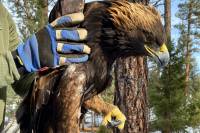US Fish and Wildlife Sued for ‘Failing to Protect’ Species, Habitats From Lead Ammo
The lawsuit focuses on grizzly bears, big cats, and other protected species in a wide swath of the country. Lead ammunition and accidental quarry are the main points of contention.
On Monday, the Center for Biological Diversity and several allies sued the U.S. Fish and Wildlife Service in federal court in Missoula, Mont.
The lawsuit challenges a recent policy change by the Biden administration that allowed increased hunting and fishing in national wildlife refuges. It states that lead ammunition and tackle could further harm endangered species in the affected areas.
The suit levies claims under the Endangered Species Act and the National Environmental Policy Act. It concerns multiple wildlife refuges in Montana, Arizona, Florida, Texas, and South Dakota. In a statement, the Center for Biological Diversity accused Fish and Wildlife of “failing to protect” endangered species there.
“We’re going to court to ensure that our nation’s wildlife refuges actually provide refuge to endangered wildlife,” said Camila Cossio, senior attorney at the center’s Endangered Species Program. “The Fish and Wildlife Service is shrugging off the main risks that sport hunting and fishing pose to endangered animals.”
It’s important to note that a federal ban on lead ammunition already exists nationwide for waterfowl hunting, and many states take lead bans for hunting much further than that. Though California is the only state to ban lead outright for hunting, others have bans in place that span different types of hunting and state refuges.
In addition to regulation of lead, a movement among hunters to choose non-lead ammunition continues to gather steam. Organizations like the Non-Lead Partnership bring together NGOs and state wildlife agencies to tackle the issue of lead use in hunting. Many hunters are personally opting to make the change on their own.

Claim: US Fish and Wildlife Environmental Analysis Failed
The suit claims that the Fish and Wildlife Service didn’t fully consider the impact of lead ammunition, which often poisons wildlife, before signing off on the new policy in the refuges.
It also says the agency failed to consider that increased hunting will likely harm endangered species in the affected areas. It cites unacceptable risk to grizzlies in Montana, jaguars in Arizona, ocelots and jaguarundi in Texas and Florida, and various waterfowl.
“More than 500 species protected by the Endangered Species Act — nearly one-third of all U.S. listed species — are found on wildlife refuges,” the suit asserts.
“The Hunting and Fishing rule opened or expanded more than 2.3 million acres of refuge lands to sport hunting or fishing. The refuge system is essential to biodiversity. Many refuges are the only places in the world for species on the edge of extinction.”
Among hunters, the suit raises the principal concern of accidentally killing endangered species while hunting others. For instance, hunters may mistake endangered whooping cranes for sandhill cranes, North America’s most common crane.
However, the last known incident of a whooping crane being mistaken as another species happened in 2013. The hunter realized his mistake and turned himself in. And prior to that, only four other birds had been accidentally killed and reported since 1968.
In addition, tickets and fines are issued when hunters mistake one species for another, and it’s considered both unethical and unsportsmanlike to shoot at any species should one not be sure what it is.

It also addresses the Trump-era reversal of a ban on lead-based fishing and hunting gear. Increased fishing and hunting on national wildlife refuges would release more of the powerful neurotoxin into the affected habitats. This is especially true of the waterways that all species rely on.
The lawsuit concludes that the Fish and Wildlife Service did conduct an environmental analysis before implementing the new rules but claims that the analysis was flawed.
“The environmental analysis must disclose and analyze the direct, indirect, and cumulative effects of the proposed action on the environment,” the suit says. “The agency’s analysis of cumulative impacts of lead is limited to two paragraphs and contradicts their own public media statements.”
The post US Fish and Wildlife Sued for ‘Failing to Protect’ Species, Habitats From Lead Ammo appeared first on GearJunkie.

